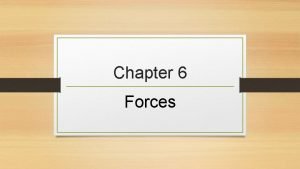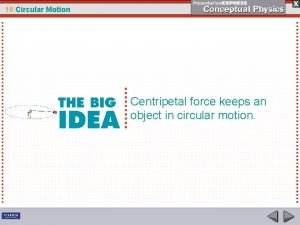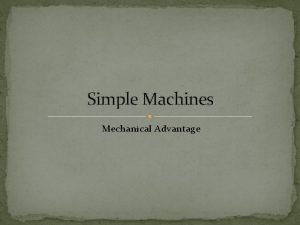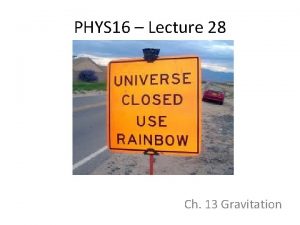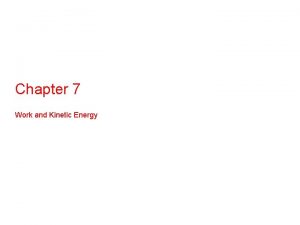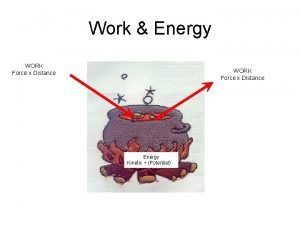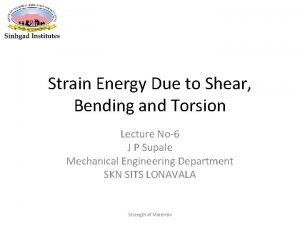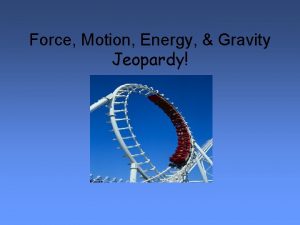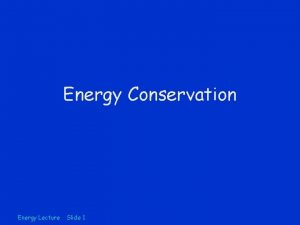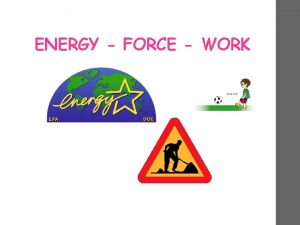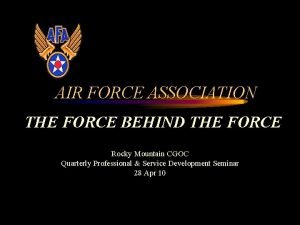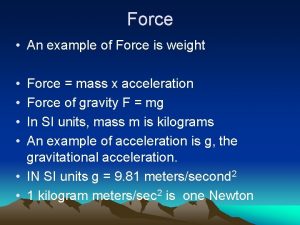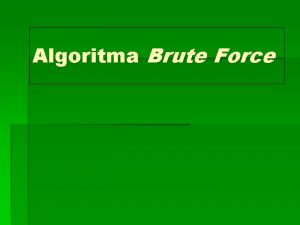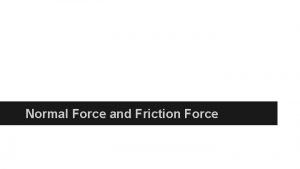Work Energy Lecture Slide 1 Work Work Force























- Slides: 23

Work & Energy Lecture Slide 1

Work • Work = (Force in direction of motion)*distance • W, Joule (J) = N-m • 1 J is work done in lifting 1 N (weight of average apple) at a constant speed, vertically 1 m Energy Lecture Slide 2

Work • Work = (Force in direction of motion)*distance • W, Joule (J) = N-m • 1 J is work done in lifting 1 N (weight of average apple) at a constant speed, vertically 1 m Energy Lecture Slide 3

No Work • person holding sign is doing no work • waiter carrying tray is doing no work • Person pushing stationary car is doing no work Energy Lecture Slide 4

Work Question 1 • A 10 N horizontal force is applied to push a block across a frictionless, horizontal surface through a distance of 5. 0 m to the right. What is the work done on the block by each of the forces shown? Energy Lecture Slide 5

Work Question 2 • A frictional force slows a moving block to a stop through a distance of 5. 0 m to the right. What is the work done on the block by each of the forces shown? Energy Lecture Slide 6

Work Question 3 • A 10 N horizontal force is applied to push a block across a frictional surface at constant speed through a displacement of 5. 0 m to the right. What is the work done on the block by each of the forces shown? Energy Lecture Slide 7

Work Question 4 • A 2 kg object slides at a constant speed across a horizontal, frictionless surface through a distance of 5. 0 m to the right. What is the work done on the block by each of the forces shown? Energy Lecture Slide 8

Work Question 5 • A 2 kg object is pulled upward at a constant speed by a 20 N force through a distance of 5 m. What is the work done on the block by each of the forces shown? Energy Lecture Slide 9

Power • Power = Work/time • P, J/s = Watt • 1 horsepower = 746 Watts Energy Lecture Slide 10

Power Question • A 60 kg student climbs a 5 m high flight of stairs at a constant speed in 3 seconds. What is the student’s power rating? Energy Lecture Slide 11

Gravitational Potential Energy • Energy of position • Gravitational Potential Energy • PE = mgh • PE is the work done against the field to move an object to a certain position • Lifting apple 1 m – 1 J of PE • PE is the work that the object can do – Stored energy Energy Lecture Slide 12

Potential Energy Question • Use the fact that the PE of the ball at the top of the stairs is 50 J to determine the PE at the other locations. Energy Lecture Slide 13

Elastic Potential Energy • Energy stored by compressing or stretching a spring • PE = 0. 5 k x 2 • K is the spring constant – a measure of the stiffness of the spring Energy Lecture Slide 14

Kinetic Energy • KE is energy of motion • KE = 0. 5 mv 2 • Apple (0. 10 kg) thrown at 5 m/s • KE = (0. 5)(0. 10 kg)(5 m/s)2 = 1. 25 J Energy Lecture Slide 15

Kinetic Energy Question • What is the kinetic energy of my 1000 kg car when it is traveling at 25 m/s? Energy Lecture Slide 16

Work = Energy • Work produces a change in energy • Work done by friction in stopping a car is equal to the change in kinetic energy experienced by the car • F*d = -0. 5 mv 2 • How does doubling a car’s speed, affect the stopping distance? Energy Lecture Slide 17

Stopping Distance • Given that F is a fixed value for given road/tire conditions, the stopping distance is proportional to the KE • How does doubling the speed affect the KE? Energy Lecture Slide 18

Stopping Distance • Given that F is a fixed value for given road/tire conditions, the stopping distance is proportional to the KE • How does doubling the speed affect the KE? • (2 v)2 = 4 v 2 • 4 X the KE, thus, 4 X the stopping distance Energy Lecture Slide 19

Stopping Distance • How does tripling the speed affect the stopping distance? Energy Lecture Slide 20

Stopping Distance • How does tripling the speed affect the stopping distance? • (3 v)2 = 9 v 2 • 9 X KE means 9 X the stopping distance Energy Lecture Slide 21

Pulleys and Force Energy Lecture Slide 22

Pulleys and Work Energy Lecture Slide 23
 Heel toe polka music
Heel toe polka music 01:640:244 lecture notes - lecture 15: plat, idah, farad
01:640:244 lecture notes - lecture 15: plat, idah, farad Work energy theorem for a variable force class 11
Work energy theorem for a variable force class 11 Energy energy transfer and general energy analysis
Energy energy transfer and general energy analysis Energy energy transfer and general energy analysis
Energy energy transfer and general energy analysis Factoring polynomials
Factoring polynomials Utilities and energy lectures
Utilities and energy lectures Section 2 describing energy worksheet answers
Section 2 describing energy worksheet answers Is tension force contact or noncontact
Is tension force contact or noncontact Which arrow below represents the direction of acceleration
Which arrow below represents the direction of acceleration Long range force vs contact force
Long range force vs contact force If you whirl a tin can on the end of a string
If you whirl a tin can on the end of a string Advantage
Advantage What is net force
What is net force What is a centrifugal force in geography
What is a centrifugal force in geography Noncontact force definition
Noncontact force definition Is electric potential conservative
Is electric potential conservative Centripetal force and gravitational force
Centripetal force and gravitational force Normal force and gravitational force
Normal force and gravitational force Shear and moment diagram examples
Shear and moment diagram examples Physics 03-01 work and the work-energy theorem
Physics 03-01 work and the work-energy theorem Chapter 4 section 1 work and machines answer key
Chapter 4 section 1 work and machines answer key Force x distance=
Force x distance= Strain energy due to torsion
Strain energy due to torsion










